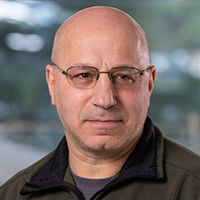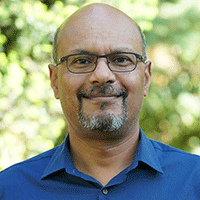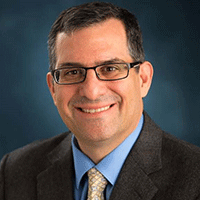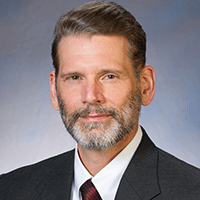FEDSM 2021 is proud to announce this year's plenary speakers:

2020 ASME Fluids Engineering Award
Prof. Howard A. Stone
Donald R. Dixon '69 and Elizabeth W. Dixon Professor in Mechanical and Aerospace Engineering at Princeton University

2021 Freeman Scholar Award
Dr. Rajat Mittal
Professor of Mechanical Engineering at the Johns Hopkins University

2021 ASME Fluids Engineering Award
Dr. Steven Ceccio
Professor, Naval Architecture and Marine Engineering; Professor, Mechanical Engineering and Applied Mechanics; Associate Dean for Academic Affairs at the University of Michigan

2021 ASME Henry R. Worthington Medal
Robert J. Visintainer
Vice President of Engineering and Research & Development
GIW Industries Inc., A KSB Company
Prof. Howard A. Stone
Lecture Title: Seeking Intersections Between Disciplines: "Boundaries" in Multiphase Flows
Tuesday, August 10th (10:00 AM – 10:45 AM EASTERN)
Abstract: Fluid mechanics has a rich history. Modern research themes introduce new questions, some of which can be understood using fundamental concepts. This feature is sometimes the case in the flows of complex fluids, which link fundamental research questions to potential applications, both in industry and for understanding natural phenomena. In this talk I will survey research questions that we have studied in recent years that have this character: (1) Although flows at modest Reynolds numbers at a T-shaped junction is a geometry where one should expect everything is known, nevertheless we uncover previously unrecognized complexity in three-dimensional solutions to the Navier-Stokes equations, which rationalize our experimental observations of particle trapping in this common flow configuration. (2) The motion of a particle adjacent to a flexible membrane links fluid and elastic responses, which we show produces interactions capable of separating particles by size. (3) We document experimentally the time and (three-dimensional) space variations of the shape of a falling thin film near an edge, and rationalize the quantitative features using a similarity scaling with a unique feature that takes a three-dimensional problem and converts it to a one-dimensional problem.
Dr. Rajat Mittal
Lecture Title: Immersed Boundary Methods-Translating Concepts into Simulations
Tuesday, August 10th (12:00 PM – 12:45 PM EASTERN)
Abstract: The last 25 years have seen a phenomenal growth in the application of Immersed Boundary Methods (IBMs) to the computational modeling of fluid flows. The power of IBM lies in the fact that it frees the fluid dynamicist from the need to generate body-conformal grids, thereby allowing rapid translation from concepts to simulations. The very early applications of the IBM were in the areas of interfacial and biological fluid dynamics, and while these remain the strongholds for these methods, application have expanded to encompass most areas of fluids dynamics including fluid-structure interaction, multiphase flows, acoustics, fluidic microdevices, heat transfer, design optimization, reacting flows and others. This expanded scope has also been accompanied by significant numerical and computational advancements in these methods. In my talk I will review the history as well as the state-of-the-art of IBMs. The particular emphasis of my talk will be on some areas that have been the focus of my own research in recent years: IBMs with improved accuracy and conservation properties, and application to biological flows, bioacoustics, and fluid-structure interaction.
Robert Visintainer
Lecture Title: Pumping Rocks: Hydrotransport and the Centrifugal Slurry Pump
Wednesday, August 11th (12:00 PM – 12:45 PM EASTERN)
Abstract: Centrifugal pumps are one of the most common machines in use worldwide, with a long history dating back to the 17th century. Applications are as varied as the pump designs themselves. In the great majority of cases, their primary purpose is the transport of some fluid, such as water, fuel or other mixtures used in the chemical and food processing industries. In some cases, the fluids may be laden with solids, for example river water, sewage, drainage, or wash water. However, a special class of centrifugal pump exists whose primary function is the transport solids, and where the fluids represent little more than a transport medium, an application sometimes referred to as "hydrotransport”". The pumps that power these systems are called slurry pumps.
Slurry pumps are common in the mineral processing and dredging industries, and as one may imagine, the erosive stresses on their pumping components are severe. The solids range from fine silt to boulders and are often handled at high concentration, since they are the primary focus of transport. They substantially alter pump and pipeline hydraulic behavior, which can be further complicated by entrained gasses or viscous fluids.
In this presentation, we will examine some of the technical challenges encountered in hydrotransport and slurry pump applications and give examples of the design strategies and scientific methods developed over the last 50 years to address them.
Dr. Steven Ceccio
Lecture Title: The Role of Compressibility on the Dynamics of Developed Cavitation
Wednesday, August 11th (10:00 AM – 10:45 AM EASTERN)
Abstract: Developed cavitation can occur on liquid flows over lifting surfaces, in the passages of turbomachinery, and in the wakes of bluff bodies. Such cavitation can be very deleterious to system performance, leading to thrust breakdown, vibration, and erosion. Alternatively, pockets of developed cavitation can be actively employed to reduce hydrodynamic resistance. The cyclical shedding of large-scale vapor and gas clouds (cloud cavitation) is an important feature of these flows, and the mechanisms responsible for sheet-to-cloud transition has received considerable study. Re-entrant liquid flow has traditionally been identified and the dominant mechanism for the creation of unstable sheet cavitation, but recent studies have revealed that a second important process is responsible for flow instability. High volume-fraction bubbly mixtures exhibit compressibility and can manifest sound speeds that are very low compared to the freestream speed of the flow. When this occurs, the local Mach number (based on local speed of sound) within the region of bubbly flow can exceed unity, leading to the formation of dynamic condensation waves. We have shown how this process leads to sheet to cloud transition, and how consideration of the local Mach number can explain a variety of previously observed flow cavity flow phenomena that cannot be explained simply with re-entrant flow dynamics. We have visualized these cavitating flows using traditional optical and cinematographic X-ray imaging. In the present talk we will explore the importance of compressibility on cavity dynamics for flows over a variety of canonical bodies and discuss the relationship between the cavitating mixture properties, the resulting sound speed (Mach number), and the formation of bubbly shock waves. We will also show how the injection of non-condensable gas can be used to suppress these flow dynamics by lowering the local mixture Mach number.
Biographies
Prof. Howard A. Stone
Professor Howard A. Stone received the Bachelor of Science degree in Chemical Engineering from the University of California at Davis in 1982 and the PhD in Chemical Engineering from Caltech in 1988. Following a postdoctoral year in the Department of Applied Mathematics and Theoretical Physics at the University of Cambridge, in 1989 he joined the faculty of the (now) School of Engineering and Applied Sciences at Harvard University, where he eventually became the Vicky Joseph Professor of Engineering and Applied Mathematics. In 1994 Professor Stone received both the Joseph R. Levenson Memorial Award and the Phi Beta Kappa teaching Prize, which are the only two teaching awards given to faculty in Harvard College. In 2000 he was named a Harvard College Professor for his contributions to undergraduate education. In July 2009 he moved to Princeton University where he is Donald R. Dixon ’69 and Elizabeth W. Dixon Professor in Mechanical and Aerospace Engineering. Presently he is the Chair of the Department of Mechanical and Aerospace Engineering and in 2017 he received the Presidential Award for Distinguished Teaching at Princeton.
Professor Stone's research interests are in fluid dynamics, especially as they arise in research and applications at the interface of engineering, chemistry, physics, and biology. In particular, he developed original research directions in microfluidics including studies and applications involving bubbles and droplets, bacteria, chemical kinetics, etc. He received the NSF Presidential Young Investigator Award, is a Fellow of the American Physical Society (APS), and is past Chair of the Division of Fluid Dynamics of the APS. For ten years he served as an Associate Editor for the Journal of Fluid Mechanics, and is currently on the editorial or advisory boards of Physical Review Fluids, Philosophical Transactions of the Royal Society, and Soft Matter, and is co-editor of the Soft Matter Book Series. Professor Stone is the first recipient of the G.K. Batchelor Prize in Fluid Dynamics, which was awarded in August 2008. He was elected to the National Academy of Engineering in 2009, the American Academy of Arts and Sciences in 2011 and the National Academy of Sciences in 2014.
Dr. Rajat Mittal
Dr. Rajat Mittal is Professor of Mechanical Engineering at the Johns Hopkins University with a secondary appointment in the School of Medicine. He received the B. Tech. degree from the Indian Institute of Technology at Kanpur in 1989, the M.S. degree from the University of Florida in 1991, and the Ph.D. degree in Applied Mechanics from The University of Illinois at Urbana-Champaign, in 1995. He directs the research of the Flow Physics and Computation Lab at Johns Hopkins University, and his research interests include computational fluid dynamics, biomedical engineering, biological fluid dynamics, fluid-structure interaction, and flow control. His awards include the 1996 Francois Frenkiel Award from the Division of Fluid Dynamics of the American Physical Society, and the 2006 Lewis Moody from the American Society of Mechanical Engineers (ASME). He is a Fellow of ASME and the American Physical Society, and an Associate Fellow of the American Institute of Aeronautics and Astronautics. He is an associate editor of the Journal of Computational Physics, Frontiers of Computational Physiology and Medicine, the Journal of Experimental Biology, and the International Journal for Numerical Methods in Biomedical Engineering.
Dr. Steven Ceccio
Steven L. Ceccio is the Vincent T. and Gloria M. Gorguze Professor of Engineering and the Associate Dean for Academic Affairs of the University of Michigan College of Engineering. He received his B. S. degree in mechanical engineering from the University of Michigan in 1985, and his M. S. and Ph. D. degrees in 1986 and 1990 in mechanical engineering from CALTECH. He became an Assistant Professor in Mechanical Engineering at UM in 1990, Associate Professor with tenure in 1996, and Professor in 2003. He served as an Associate Vice President for Research at the University of Michigan from 2004 to 2009 and as the Director of the Naval Engineering Education Center from 2010 to 2015. He was the Chair of the Department of Naval Architecture and Marine Engineering at the University of Michigan from 2011 to 2016. He served as the Associate Dean for Research of the College of Engineering from 2017 to 2020. He has served as an Associate Editor of the Journal of Fluids Engineering. Prof. Ceccio is a fellow of the American Society of Mechanical Engineers and of the American Physical Society, and he was named the 2014 Freeman Scholar by ASME
Robert J. Visintainer
Robert has worked in the design, testing and manufacture of centrifugal pumps since 1981. As Vice President of Engineering and R&D for international slurry pump manufacturer GIW Industries, he is responsible for product design, product management, materials development, hydraulic R&D, technical training and GIW’s unique Slurry Hydraulic Test Lab. He also serves as the engineering lead for product development and management within the KSB Global Mining organization. Robert has contributed to many developments and innovations in slurry pump design and the modelling of concentrated solid-liquid flows. These have included industry leading, two-phase, CFD models for pump wear prediction, experimental methods for measuring solid-liquid flows within pumps and pipelines, models for predicting their performance, wear mechanism research for materials development, and centrifugal pump theory for viscous slurries and the handling three-phase solid-liquid-gas mixtures. He has contributed to more than 100 pump designs installed world-wide in the mining and dredging industries, and to numerous scientific conferences, journals and industry short courses.
Robert has a special interest in developing the next generation of pump engineers, and is responsible for GIW’s Technical Training Program, including the well known course for "Slurry Transport using Centrifugal Pumps", now in its 44th year.